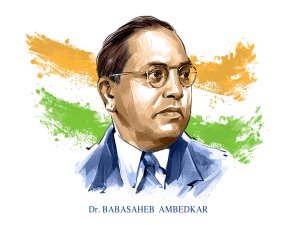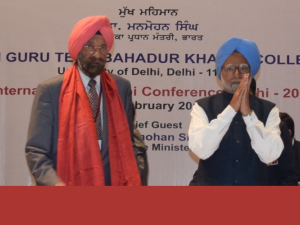In 1953, Khushwant Singh expressed concerns of practicing Sikhs when he published his book “The Sikhs” and feared that there would be complete disappearing of them by the turn of the century. Khushwant Singh had written an epitaph for his own community, the great brotherhood of Sikhs initiated into the order of Khalsa by Guru Gobind Singh.
During the 60’s we saw a mass exodus of Sikhs migrating to the West in search of jobs and fortune. At this time amongst the Sikh youth a pervasive kind of pessimism manifested. The bana (uniform) of Khalsa appeared wholly incongruent to them with the spirit of the newly emerging age. There was a mad race among this new generation of Sikhs to turn clean-shaven, so as not to look out of place within the general mass of humanity. The problem further intensified in their newly adopted homes in different countries. The trend seemed irreversible!
By a quirk of destiny, barely two decades later in 1974, a comparative unknown Sikh from Los Angeles, USA arrived in India with a group of 84 American Sikhs. These new Sikhs were proudly resplendent in their bana (uniform of the Khalsa). They were young men and women who had found solace in Sikhism and came to India to partake of Amrit at the Golden Temple, Amritsar, the holiest seat of Sikhism in the world. That these young Americans had taken to Sikhism on their own free will, which only a few could believe. Most of us conjectured that it could be no more than a gimmick of a generation of hippies who would do anything to escape the directionless current of a opulent society. Little did we know that these few were the steel foundation of the Westerns Khalsa.
The sixties had caused the idealistic American youth to seek refuge in booze, drugs and the sexual revolution. Disillusioned, this generation roamed the globe rebels on the fringe of society. But, this time history recorded a different story. These new Sikhs had found a lasting commitment. The humble beginning of Sikhism in the West became a tidal wave over the next three decades. The once unknown man called Yogi Bhajan was now well known, to lead the Western youth to Sikhism in vast numbers. Thanks to his great work in the Western Hemisphere, and around the world, there is hardly a big city anywhere, without Sikhs of non Indian origin living and practicing the toughest drill of the tenth Master, Guru Gobind Singh. They greet one another with Sat Nam and are learning to speak Punjabi. Most already read Gurbani and do their prayer daily in the prescribed Sikh way. More than this they are growing in number, and firmly believe in the prophesy ascribed to Guru Gobind Singh that Khalsa shall become 960 million strong and shall rule the destiny of the world.
In other words, these Westerners have found their spiritual equation in Sikhism and have developed the commitment which motivates them to work hard and succeeded, for their future. It is such a short time since Khushwant Singh was prompted to make that doomsday prophesy, he was himself witness to this miracle that was accomplished through the Amrit of Sikhism. He wrote a column to praise Kirtan by a American Sikh Jatha in Golden Temple and admitted his wrong prophecy.
Bhajan Yogi was known as Siri Singh Sahib Harbhajan Singh Khalsa Yogiji. The titles of Siri Singh Sahib and Bhai Sahib were conferred officially upon him by the SGPC and Akal Takht in 1971 and 1974 respectively. He performed something which may have no parallel in Sikh history. In the month of April in 1999, he came to India, with another group of 400 and their children born into Sikhism, each one eager to participate in the Tercentenary Celebrations of the Birth of Khalsa, on Baisakhi Day, April 14th at Anandpur Sahib. He presented a most costly sword studded with diamonds at the Takhat. In that historic congregation which was attended by entire Sikh leadership Yogi alone was honoured by Jathedar Takhat.
I am quite certain that this new movement of Sikhs from non-Indian origin has the potential and will develop more influentially in the West and around the world as the Buddhist religion has done in earlier years.
Yogi Bhajan had no claims and neither did he want to build his own spiritual empire. He began to minister to the needs of the Western youth. Through Kundalini Yoga he helped a generation to heal their minds and bodies from the ravages of drugs and abuse. Kundalini Yoga became a gateway for the Western youth into Sikhism.
Sikh Dharma of the West functions on the time-tested missal and Jathedari system of the Sikhs of Indian origin. The Sikh custom of Dasvandh, giving 10% of one’s earnings for the furtherance of Sikhism, is also observed, and further more all of these Sikhs of different races born outside of India are pure vegetarians. Today his mission continues worldwide in Japan, Africa, Germany, Holland, Norway, the UK, the USA as well as many other Countries around the world.
This week, the 3HO Foundation honors its 54th anniversary. We are grateful to Sardar Tarlochan Singh ji for sharing some of his personal memories about the founding and development of the movement that brought the Guru's light and mission to people in the West.
SikhNet is honored that Sardar Tarlochan Singh ji, EX-MP, Former Chairman National Commission Minorities, India is sharing his personal recollection of historical events with our audience.
The opinions expressed here are personal to the author and do not necessarily reflect an editorial position of the SikhNet staff or board.





